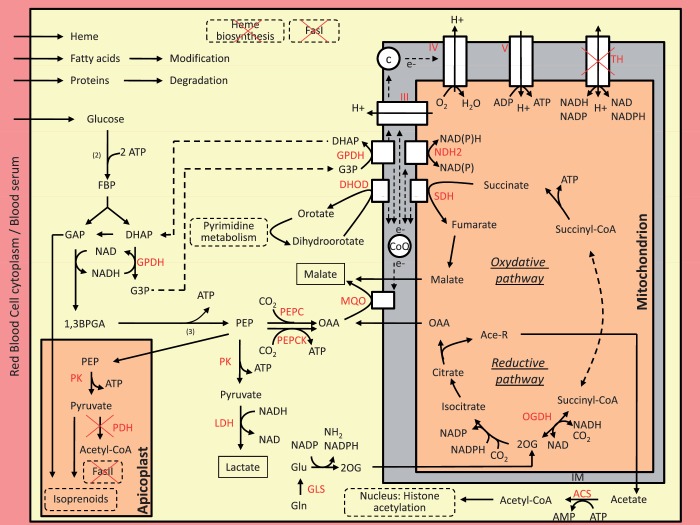Figure 5.
An integrated model for central metabolism of Babesia microti. Arrows show the direction of net fluxes. Lactate and malate are expected to be the major end products of the central metabolism. The gene encoding the lactate dehydrogenase is likely obtained by lateral transfer from a mammalian host. The apicoplast is devoted to the production of isoprenoids precursors. Numbers in brackets represent the biochemical steps in the reaction. Dashed arrows connect two reactions using the same metabolite. For simplicity, the membranes of the apicoplast and the outer membrane of the mitochondrion is not shown. Abbreviation used are: (1) Metabolites: 1,3BPGA, 1,3-bisphosphoglycerate; 2OG, 2-oxoglutarate; Ace-R: acetate/acetyl-CoA, c, cytochrome c; CoQ, Coenzyme-Q, ubiquinone; DHAP, dihydroxyacetone phosphate; e-, electrons; FBP, fructose 1,6-bisphosphate; G3P, glycerol-3-phosphate; GAP, glyceraldehyde-3-phosphate; Glu, glutamate; Gln, glutamine; OAA, oxaloacetate, PEP, phosphoenolpyruvate. (2) Enzymes (in red): ACS, AMP-forming acetyl-CoA synthetase; DHOD, dihydroorotate dehydrogenase; GLS, glutamine synthetase; GPDH, glycerol-3-phosphate dehydrogenase (FAD- or NAD-dependent enzymes); LDH, lactate dehydrogenase; MQO, malate:quinone oxidoreductase; NDH2, type II NADH:quinone oxidoreductase; OGDH, oxoglutarate dehydrogenase; PEPC, PEP carboxylase; PEPCK, PEP carboxykinase; PDH, pyruvate dehydrogenase; PK, pyruvate kinase; SDH, succinate dehydrogenase; TH, transhydrogenase; III, complex III of the respiratory chain; IV, complex IV of the respiratory chain; V, F0F1-ATP synthase.

